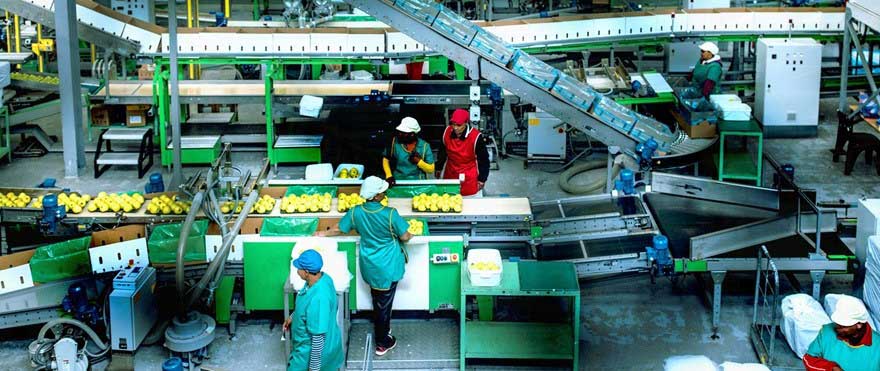How do businesses like yours face sales and payments management challenges from both external and internal sources. And how are they transforming challenges into opportunities?

The key to good cash flow management? Good sales management
Back to Managing sales and customersFor manufacturing and producing businesses, looking after cash flow and balance sheet health means looking at the processes you have in place – on both the supply side and the buy side. But the landscape has changed in light of COVID-19, and will continue to change moving forward. Businesses like yours are having to make decisions in order to keep up with industry challenges.
There’s also the direct and indirect impact of trade tariff changes to contend with, while many businesses are steadily moving away from a traditional distribution model in favour of a direct to customer approach.
We spoke to a number of manufacturing and producing businesses from all over the world to find out how they feel about the challenges affecting the industry – particularly when it comes to managing the sales and payment process in an unstable global trading environment.
Are you keeping up with ever-changing consumer demands?
Disruption comes in many forms. External risk from buyers is varied, and often depends on the nature of your manufacturing business.
For producers closer to the retail end of the chain, the main driver of change is a shift in sales channels – like direct-to-consumer distribution channels such as Amazon, eBay and Alibaba. What’s more, demand for online retail has soared following strict measures put in place to tackle COVID-19. A director at a consumer goods manufacturing and retail business said: “We’ve maintained some of the historic trading business but we’re not looking for new trade customers… There’s more value and success if we develop and sell our own brands direct to consumers.”
Why are some manufacturers finding more value in direct-to-consumer channels? Because when you have direct relationships with your customers, you avoid distribution risks. You are in control of sales at every point, which means you’re more likely to have the right amount of stock at the right time.
Selling direct also means you get cash quicker and have more control over your brand. For businesses that operate a franchise model, there can be concerns around potential discrepancies in how things are set up and managed. As one financial controller at a large luxury retail corporate put it: “How franchisees decide to run their business is out of our control, which makes me worry about reputational risk to our brand.” If you sell direct, you’re able to oversee all elements of your business, and manage everything from your sales to your reputation.
Is having just a few key buyers causing you problems?
At the other end of the scale, having just a few large customers can be risky because it puts the buyer in a strong negotiating position. Manufacturing businesses with large contracts have significant supply chain commitments, and any delay in payment can cause a financial headache.
Our contracts are very large and complex and take a long time to produce. Sometimes when customers are late in paying it creates problems, like additional expensive hedging costs to compensate.
|
If your manufacturing business depends on one or a few key customers, you’re more invested in maintaining the customer’s success than improving your own margins as a producer. Over time, this can make your business vulnerable.
The solution? To work with your customers as strategic partners to innovate – and support this with appropriate investment. “It’s a shared responsibility to look after customer relationships,” said the finance director of a large aerospace corporation. “When you have a good relationship with the customer, dealing with financial matters is a lot easier.”
Are you doing enough to optimise internal processes and keep DSO to a minimum?
Cash flow is the lifeblood of any business, and a measure of healthy cash flow is days sales outstanding (DSO). Put simply, the sooner you get your cash, the stronger your cash flow will be.
It stands to reason that any delay in payment will have an impact on your financial position. So how can you improve business and reduce your DSO?
Reducing DSO needs effort on the part of your finance executives, but it also needs the cooperation of various other departments too. And the best place to start is with data on your current DSO status, and to benchmark analysis of that data against your peers.
DSO is often driven by your customers’ ability to pay on time. So, it makes sense that DSO can be reduced by addressing customer credit risk and tightening credit approvals. However, the flipside is that gaining new and keeping current customers might suffer. After all, you don’t want to lose out on a sale because a customer has credit problems. It’s up to you, then, to decide the circumstances in which you can offer incentives for faster payments, or when you might require upfront payments.
At the same time, if you’re expanding into new growth markets, late or non-payment is always a risk, and figuring out the most efficient way to distribute and sell your products globally can be a real challenge. Selling products internationally makes it hard to standardise buyer payment terms. That’s because different markets have different competition and regulatory environments that need to be taken into account.
In some countries we sell to, the demand side is much more competitive than others. That means we don’t get to push our days sales outstanding (DSO) out, otherwise customers will expect to pay less as a trade-off.
|
Can new technologies make your sales and payments tighter?
Business banking is rapidly moving away from paper-based payments to card-based and digital payments. This reduces the time it takes for you to receive money from customers and gives your customers the flexibility to pay how they want to.
Efficient cash management doesn’t just happen, though. It’s helped by technology, like platforms that provide a way of collecting outstanding payments at the fastest speeds and lowest costs possible, working in tandem with your back-end systems.
We’ve removed paper from our sales and service process. We’re using tablets to process all of our business transactions. This increases our pace and reduces the time it takes to get from order to cash for the business. It also reduces operational risk through minimising errors.
|
Manual processes for accounts receivable could struggle to keep up with the pace of trade – especially as things pick up following major events like the COVID-19 pandemic. Poor visibility and control can inhibit the true overall picture of sales outstanding, which creates more work having to chase payments manually. One finance manager in a growing mid-market enterprise in the packaging industry said: “In accounts receivable, I use a scorecard to assess performance in order to maximise the cash we receive into the business. We often have to respond to late payments and chase customers.”
Using technology can help reduce the length it takes to convert your investments in inventory into cash flow from sales. And automating processes speeds up cash collection and gives you access to up-to-date information.
Speed to market and ‘order to cash’ time makes a big difference to both the top and bottom line… The improvements we have made in the use of technology have made a huge difference.
|
Is your sales process fully optimised?
In an ideal world, we’d all like to be confident that things will go smoothly. However, no one can predict what uncertainties will arise when, so it always pays to be a step ahead.
To ensure the effectiveness of your sales and payments processing, it’s important to ask some questions of your business – like are you in the know when it comes to current and potential risk from external factors? Are you aware of any risk caused by your own internal processes? And do you have the technology in place to help overcome these challenges?
Key insights from growing manufacturers on the best ways to manage sales

Find out what you can learn about managing sales processes from other businesses at different stages of growth


See how banking and finance solutions can give you more control over managing sales processes
Award-winning banking

Middle East's Best Bank for Transaction Services
We are industry innovators, at the forefront of technological changes in transaction banking

Best Global Trade Finance Bank
We never stop working to understand the needs of every small business

Best Regional Cash Manager - Middle East
We've made significant investments into digital products and channels to deliver transformational cash management services
Find out more about Managing sales and customers
Makers Hub
How are manufacturers turning uncertainty and disruption into business advantage? And what can you learn from them?
Supply Chain
How can you strengthen your supply chain finances to deal with unstable conditions?
Protect Your Business
Protecting your business from risk is crucial when trading with new global partners – especially during times of market instability.
Cash Flow
Maximising your cash flow can help you stay resilient and drive growth, even in unstable trading conditions.


